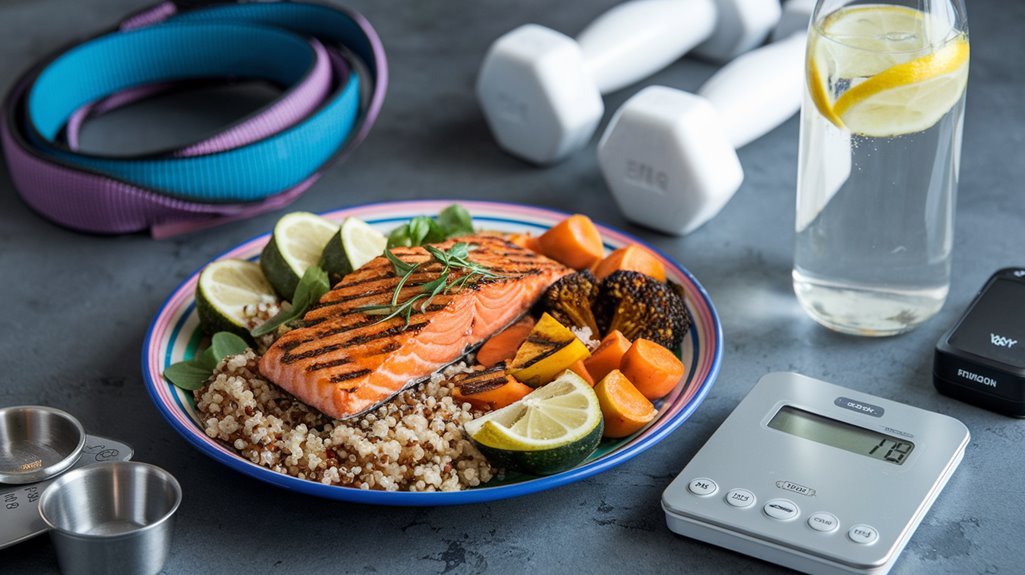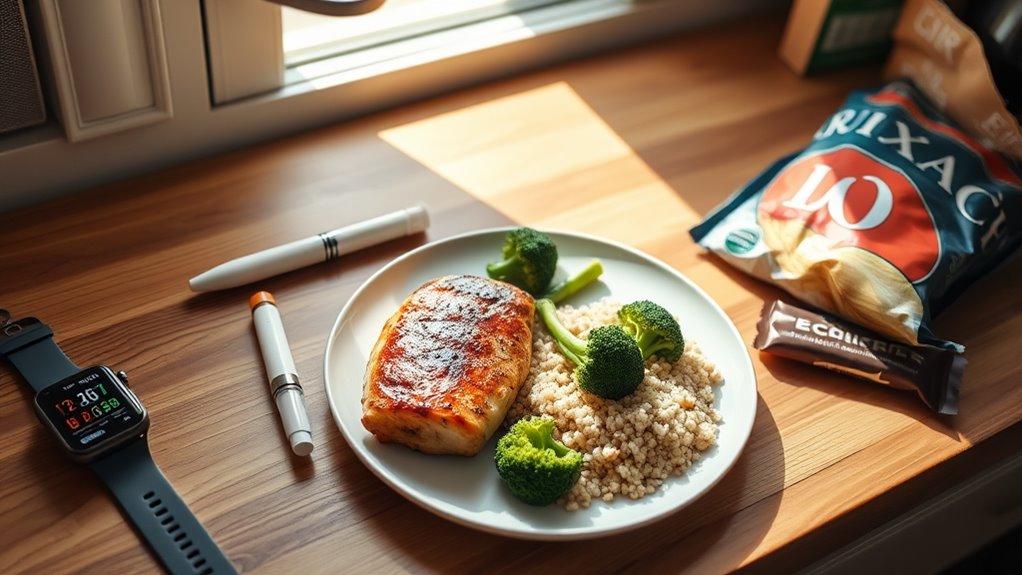Optimize your Mounjaro results with proven diet and exercise strategies that transform your weight loss journey - but there's more you need to know.

When taking Mounjaro, you'll need to combine specific dietary and exercise strategies for best results. Focus on consuming 0.8-1.5g of protein per kilogram of body weight, prioritizing lean meats and fiber-rich whole foods while limiting processed carbohydrates. Aim for 150 minutes of moderate cardio plus two strength training sessions weekly. Structure your meals carefully, stay hydrated with 6-8 servings of fluid daily, and track your progress consistently. Understanding the complete framework of lifestyle modifications will enhance your success with Mounjaro therapy.
When starting Mounjaro treatment, understanding the critical role of diet becomes essential for optimizing therapeutic outcomes. While there's no predetermined diet plan, you'll need to focus on incorporating specific food groups that complement the medication's effects. Your dietary strategy should emphasize lean proteins, fiber-rich whole grains, and low glycemic index fruits to maintain stable blood sugar levels. Aim for protein between 0.8 to 1.5 grams per kilogram of body weight each day to support your health goals.
You'll achieve better results by prioritizing nutrient-dense foods while limiting processed items, excessive sodium, and alcohol consumption. The combination of Mounjaro with appropriate dietary choices helps regulate blood glucose, minimize potential side effects, and enhance treatment efficacy. Your meal planning should include careful portion control and adequate hydration, particularly given Mounjaro's effects on appetite and metabolism.
Consider implementing structured eating approaches, such as the Mediterranean diet, or adopting an 80/20 framework that allows for sustainable long-term adherence while maintaining therapeutic benefits.
To optimize your Mounjaro treatment outcomes, focusing on specific food groups becomes essential for managing blood glucose levels and supporting sustainable weight management. You'll want to prioritize lean proteins like chicken breast, fish, and eggs, which promote satiety and help maintain muscle mass during weight loss.
Incorporate fiber-rich foods, including leafy greens, cruciferous vegetables, and whole grains, as they'll help regulate blood sugar and improve digestive health. Studies show that resistant starch forms when boiled potatoes are cooled, providing additional weight loss benefits. Using LED light bulbs in your kitchen can reduce energy costs while preparing healthy meals. Choosing biodegradable packaging for food storage helps reduce environmental toxins and promotes better public health. Complex carbohydrates from sources like quinoa, brown rice, and root vegetables provide sustained energy while supporting glucose control.
Don't overlook healthy fats from sources like avocados, but practice portion control. Include metabolism-boosting ingredients like cayenne pepper, which contains capsaicin that may enhance calorie burn. Remember to balance your plate with 2.5 cups of vegetables and 2 cups of fruits daily, while limiting processed foods high in saturated fats and added sugars.
Successful meal planning serves as the cornerstone of your Mounjaro treatment protocol, requiring strategic preparation and thoughtful organization. You'll need to implement batch-cooking sessions during weekends, preparing portioned meals that combine lean proteins, high-fiber carbohydrates, and healthy fats. Keep your kitchen stocked with sustainable containers for storing prepped ingredients and leftovers efficiently. Consider using beeswax wraps to preserve fresh ingredients and reduce plastic waste in your meal prep routine.
Structure your daily intake around consistent meal timing, prioritizing larger portions earlier when your metabolism is most active. You'll want to maintain stable energy levels by spacing smaller, frequent meals throughout the day while staying hydrated with unsweetened beverages. Don't skip meals, as this can destabilize blood sugar levels. Consider using measuring cups or scales to accurately portion your meals and avoid overeating.
Focus on nutrient-dense whole foods, incorporating a variety of fruits, vegetables, and lean proteins like fish, eggs, and tempeh. Keep healthy snacks accessible for between-meal hunger management. Monitor your body's hunger and fullness cues closely, and schedule regular check-ins with your healthcare provider to adjust your meal plan as your treatment progresses.
Your grocery shopping strategy plays a fundamental role in supporting your Mounjaro treatment outcomes. Navigate the store's perimeter to access fresh produce, lean proteins, and low-fat dairy while minimizing exposure to processed foods. You'll find essential whole grains, legumes, and healthy fats in select center aisles. Bring reusable produce bags to minimize single-use plastic waste while shopping for fresh ingredients. Using beeswax food wraps helps keep produce fresh while eliminating single-use plastics at home.
To optimize your shopping, eat before visiting the store and create a detailed list aligned with your meal plan. Stock up on protein-rich foods like lean meats, fish, eggs, and Greek yogurt to maintain muscle mass. Select fiber-rich whole grains such as quinoa, brown rice, and oats to promote satiety. Include healthy fats from nuts, seeds, and olive oil to support your nutritional needs. Choose foods with soluble fiber content to help reduce harmful belly fat.
Choose stores with extensive fresh produce sections and knowledgeable staff who can guide your selections. Replace sugary beverages with water or sugar-free alternatives. Focus on whole foods with minimal ingredients to maximize your treatment's effectiveness while maintaining proper portion control.
You'll need to combine both cardio exercises and strength training to optimize your weight loss journey with Mounjaro, targeting 150 minutes of moderate aerobic activity plus two strength sessions weekly. For cardiovascular health, incorporate activities like brisk walking, swimming, or cycling, while maintaining muscle mass through resistance training with weights or bodyweight exercises. To build consistency, start with shorter, manageable workouts and gradually increase intensity, allowing adequate rest between sessions to prevent overtraining and promote recovery. Following a personalized exercise plan designed by fitness experts can help ensure your workout routine aligns with your specific fitness level and goals.
When pursuing weight loss while taking Mounjaro, combining cardiovascular exercise with strength training creates a synergistic effect that maximizes metabolic benefits. Strength training builds muscle mass, which increases your resting metabolic rate and promotes excess post-exercise oxygen consumption (EPOC), leading to sustained calorie burn after workouts. Meanwhile, cardio activities enhance fat oxidation and cardiovascular health. Aim for at least 150 minutes weekly of moderate-intensity cardiovascular exercise for optimal results.
To optimize your results, you'll need to incorporate varied exercises targeting different muscle groups while engaging in diverse cardio activities like running, cycling, or swimming. This thorough approach not only accelerates fat loss but also improves body composition, reduces injury risk, and enhances mental well-being. Start gradually and progress systematically, ensuring proper form and technique. If you have underlying health conditions, consult your healthcare provider before beginning this exercise regimen.
A successful weight loss journey with Mounjaro requires structured exercise goals that align with established clinical guidelines. You'll need to engage in either 150 minutes of moderate-intensity cardio or 75 minutes of vigorous-intensity cardio per week, with flexibility to combine both intensities for best results. Incorporating HIIT workouts maximizes workout efficiency and fat burning potential.
| Activity Type | Weekly Duration | Intensity Level | Calorie Impact |
|---|---|---|---|
| Moderate Cardio | 150 minutes | Walking, cycling | 7.6-9.7 cal/min |
| High Intensity | 75 minutes | Running, swimming | 12+ cal/min |
| Strength Training | 2-3 sessions | Weight-bearing | Metabolism boost |
| Flexibility Work | 2+ sessions | Low-moderate | Muscle support |
Structure your weekly routine to include most days of exercise, starting with shorter sessions and progressively increasing duration. Combine aerobic activities with strength training to preserve muscle mass while supporting your Mounjaro-assisted weight loss efforts.
Building a consistent exercise routine requires a methodical approach that aligns with Mounjaro's metabolic effects. You'll want to start with brief exercise sessions, gradually increasing duration as your body adapts. Begin with low-impact activities like walking or swimming, then progress to more intensive cardio that elevates your heart rate. The CDC recommends getting 150 minutes weekly of moderate exercise for optimal health benefits.
Incorporate both aerobic exercises and strength training to optimize your results. While activities like cycling can burn 400-750 calories hourly, resistance training prevents muscle loss during your weight loss journey. HIIT sessions can accelerate fat burning, but make sure you're building up to higher intensities systematically. Combine your exercise routine with Mounjaro's effects by maintaining regular physical activity that includes cardio, strength work, and flexibility training. This thorough approach maximizes fat loss while preserving lean tissue.
Maintaining proper hydration and nutrition timing is essential while taking Mounjaro to optimize its effectiveness and minimize potential side effects. You'll need to consume 6-8 servings of fluid daily, but timing is vital – avoid liquids during meals and for 30 minutes before and after eating. Instead, sip fluids between meals and incorporate electrolyte-rich beverages like coconut water or bone broth.
For nutrition timing, structure your meals to be smaller and more manageable throughout the day. Focus on lean proteins while limiting carbohydrates and fats to prevent gastrointestinal discomfort. It's important to maintain electrolyte balance by including foods like bananas, avocados, and leafy greens in your meal plan. Don't consume heavy meals, and space your eating windows appropriately to allow Mounjaro to work effectively. Watch for signs of dehydration such as dry mouth, fatigue, and muscle cramps, adjusting your fluid intake accordingly. Consider incorporating soothing herbal teas like ginger, fennel, or chamomile to support digestive health.

You'll build sustainable habits with Mounjaro by implementing mindful eating strategies, such as setting a designated eating space, removing distractions, and focusing on each bite's texture and flavor. Regular exercise shifts from a short-term task to a lifestyle change when you establish consistent workout schedules, track your progress, and celebrate non-scale victories like increased strength and endurance. Integrating both mindful eating and purposeful movement creates a foundation for long-term success with your Mounjaro treatment plan, especially when combined with proper medication adherence. Starting with moderate activities like short walks and basic stretching helps build an exercise routine that complements your weight loss journey. Consider using reusable water bottles during workouts to maintain hydration while reducing environmental impact. Using silicone containers for meal prep can support your healthy eating goals while promoting environmental sustainability.
Practicing mindful eating alongside Mounjaro therapy creates a synergistic approach to sustainable weight management through heightened awareness of food choices and consumption patterns. You'll enhance your treatment outcomes by implementing specific mindful eating techniques: slow down during meals to improve digestion and nutrient absorption, focus on portion control, and eliminate distractions while eating. Consider repurposing leftovers into creative new meals to maximize your food usage.
Choose whole, minimally processed foods and incorporate plant-based protein alternatives like lentils and chickpeas into your meals. Pay attention to your food's origins by selecting locally sourced, seasonal produce whenever possible. This approach not only supports your weight management goals but also promotes environmental sustainability. Plan your meals carefully to reduce food waste, and use reusable containers to minimize packaging waste, creating an all-encompassing strategy that benefits both your health and the environment. Select biodegradable containers for takeout meals when reusable options aren't available. Food scraps and packaging materials that are industrially compostable break down completely within 180 days under proper conditions.
Building sustainable exercise habits alongside mindful eating amplifies the effectiveness of Mounjaro therapy through proven physiological mechanisms. Start by incorporating small, manageable increments of physical activity, aiming for 150 minutes of moderate exercise weekly. You'll maximize results by stacking new exercise routines with existing daily habits, such as morning stretches before coffee or walking during phone calls.
Schedule specific workout times and diversify your routine with both cardio and strength training. This balanced approach can reduce cardiovascular mortality by 22-31% when meeting recommended activity levels. For ideal outcomes, track your progress using SMART goals, maintain consistent hydration, and prioritize regularity over intensity. Remember that even modest increases in daily movement can add up to 11 years to your life expectancy. Adding both moderate and vigorous activities to your exercise plan provides optimal benefits for reducing mortality risk.
Successful weight management with Mounjaro requires a systematic approach to tracking progress through multiple data points and metrics. You'll need to establish weekly weight check-ins at consistent times while monitoring non-scale victories like improved energy levels and sleep quality. Track your body measurements every few weeks to assess changes in composition.
Maintain a detailed journal of your food intake, exercise, and emotional states using tracking apps to identify patterns and guarantee compliance with your caloric goals. The dual receptor targeting of Mounjaro makes it especially important to track metabolic changes over time. Monitor your blood sugar levels and insulin sensitivity to gauge Mounjaro's effectiveness beyond weight loss. Regular consultations with healthcare providers will help adjust your treatment plan based on tracked data.
Don't rely solely on the scale – incorporate thorough tracking methods including body measurements, energy levels, sleep quality, and mood indicators. These metrics will help you make informed adjustments to your diet and exercise routines when progress plateaus.

While you may be tempted to skip meals during your Mounjaro treatment, irregular eating patterns can disrupt blood sugar levels and trigger compensatory overeating later in the day. Hidden sugars in processed foods, condiments, and beverages can accumulate rapidly, potentially offsetting the glucose-regulating benefits of Mounjaro therapy. A dedicated focus on tracking food intake using nutrition apps helps maintain awareness of total calories consumed throughout the day. Mindless snacking between meals, even on seemingly healthy foods, can substantially increase your daily caloric intake beyond recommended levels and impede your weight loss progress.
Although skipping meals may seem like a shortcut to accelerate weight loss on Mounjaro, this approach triggers counterproductive metabolic responses that sabotage long-term success. When you skip meals, your body's resting metabolism slows down, while hunger hormones increase and fullness hormones decrease, setting you up for overeating later.
You'll experience compromised immune function, cognitive decline, and difficulty concentrating. Your body becomes less efficient at fighting infections due to disrupted immune cell balance. Low energy levels persist throughout the day when meals are skipped, making it harder to stay active and productive. The psychological impact is equally concerning – you'll likely develop an unhealthy relationship with food and struggle to recognize satiety cues. Instead, focus on balanced meals with lean proteins, whole grains, and non-starchy vegetables while practicing mindful eating. This approach optimizes Mounjaro's effectiveness while maintaining stable blood sugar levels.
Despite labels touting "natural" or "healthy" claims, hidden sugars lurk in 74% of packaged foods, posing a significant challenge for Mounjaro patients pursuing weight loss goals. You'll find these sugars in unexpected places – from savory pasta sauces to whole-grain breads. Even reduced-fat products often compensate with added sugars, potentially disrupting your metabolic response to Mounjaro. The average American unknowingly consumes 57 pounds of sugar annually through everyday packaged foods.
| Hidden Source | Sugar Impact | Action Step |
|---|---|---|
| Dried Fruit | High caloric density | Limit portions to 1-2 tbsp |
| "Low-Fat" Items | Added sugars for taste | Choose full-fat versions |
| Pasta Sauces | 6-12g sugar per serving | Make homemade alternatives |
| Condiments | Hidden corn syrup | Read labels carefully |
| Bread Products | Refined sugars added | Select whole grain options |
Monitor food labels vigilantly and prioritize whole, unprocessed foods to maximize Mounjaro's effectiveness for weight management.
Since mindless snacking can add hundreds of unaccounted calories to your daily intake, it's crucial to recognize how this behavior impacts Mounjaro's effectiveness. While Mounjaro helps slow stomach emptying and promotes satiety, unconscious eating patterns can override these benefits, potentially compromising your weight loss progress. These habits often lead to consuming snacks that are high in sugars and unhealthy fats, putting you at increased risk for health complications.
To maximize Mounjaro's effectiveness, focus on planned, nutrient-dense meals and practice mindful eating techniques rather than succumbing to impulsive snacking behaviors.
While achieving initial weight loss with Mounjaro represents a significant milestone, maintaining long-term success requires implementing sustainable lifestyle modifications. You'll need to integrate consistent dietary strategies by focusing on whole foods, maintaining proper portion control, and ensuring adequate hydration while limiting processed foods that can trigger weight regain. Many patients experience significant weight regain when discontinuing treatment without proper lifestyle modifications in place.
Your exercise routine should combine 150 minutes of weekly moderate-intensity cardio with regular strength training sessions. Gradually progress your workout intensity to prevent burnout and injury while incorporating varied activities that you'll enjoy long-term. Track your progress regularly through measurements and non-scale victories, and maintain regular check-ins with your healthcare provider to optimize your Mounjaro dosage. Remember that successful maintenance depends on the synergy between medication management and lifestyle habits, including mindful eating practices and strong support systems. You'll need patience and consistency as you evolve toward sustainable, medication-supported weight management.
You can drink alcohol occasionally while on Mounjaro, but you'll need to monitor blood sugar levels closely, eat beforehand, and stay hydrated to minimize risks of hypoglycemia and digestive issues.
You'll need to wait 2-3 hours after full meals, 30-60 minutes after snacks. Light activities like walking are fine immediately, but high-intensity exercises require longer waiting periods.
Like building a safety net, vitamin supplements can support your health during treatment. You'll need to consult your healthcare provider first, as individual needs vary based on diet and weight-loss rate.
If you miss a meal while on Mounjaro, you'll risk blood sugar fluctuations and increased gastrointestinal side effects. You should maintain regular, balanced meals to optimize the medication's effectiveness and minimize complications.
You can safely follow vegetarian or vegan diets while taking Mounjaro, but guarantee you're meeting protein requirements through plant-based sources like legumes, tofu, tempeh, and maintaining adequate B12 supplementation.
Your journey with Mounjaro represents a bridge between medical intervention and lifestyle transformation. Like a well-calibrated scale, you'll need to balance nutritional intake with physical activity, while the medication acts as your metabolic compass. Through precise caloric monitoring and structured exercise protocols, you've developed a foundation for sustainable weight management. Continue to fine-tune these elements, as each adjustment serves as another building block in your long-term health architecture.